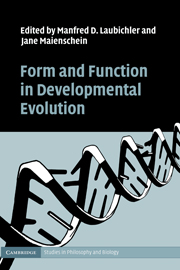Book contents
- Frontmatter
- Contents
- List of figures
- List of tables
- List of contributors
- List of journal abbreviations
- 1 Introduction
- 2 Form and function in Evo Devo: historical and conceptual reflections
- 3 Deducing plant function from organic form: challenges and pitfalls
- 4 Evolution in the light of embryos: seeking the origins of novelties in ontogeny
- 5 A focus on both form and function in examining selection versus constraint
- 6 Innovation and diversity in functional morphology
- 7 The developmental evolution of avian digit homology: an update
- 8 Functional analysis and character transformation
- 9 The nature of constraints
- 10 Toward a mechanistic Evo Devo
- Index
- References
7 - The developmental evolution of avian digit homology: an update
Published online by Cambridge University Press: 28 June 2009
- Frontmatter
- Contents
- List of figures
- List of tables
- List of contributors
- List of journal abbreviations
- 1 Introduction
- 2 Form and function in Evo Devo: historical and conceptual reflections
- 3 Deducing plant function from organic form: challenges and pitfalls
- 4 Evolution in the light of embryos: seeking the origins of novelties in ontogeny
- 5 A focus on both form and function in examining selection versus constraint
- 6 Innovation and diversity in functional morphology
- 7 The developmental evolution of avian digit homology: an update
- 8 Functional analysis and character transformation
- 9 The nature of constraints
- 10 Toward a mechanistic Evo Devo
- Index
- References
Summary
INTRODUCTION
It is a truism of evolutionary developmental biology that the evolution of phenotypic characters has to be caused by the evolutionary modification of their developmental pathways (Hall 1998; Raff 1996). Surprisingly, however, the evolutionary conservation of a phenotypic character does not imply the conservation of its developmental pathway (Hall 1994; Wagner and Misof 1993; Weiss and Fullerton 2000). A paradigmatic case of this problem is the homology of the digits in the bird wing. Phylogenetic evidence conclusively shows that the digits of the bird wing are the thumb, the index finger, and the middle finger – that is, digits DI, DII, and DIII (Sereno 1999b). The embryological origin of these fingers, however, is identical to that of those fingers that usually form the index, middle, and “ring” finger – that is, digits DII, DIII, and DIV (Burke and Feduccia 1997; Hinchliffe and Hecht 1984; Müller and Alberch 1990). This discrepancy has been unresolved since the discovery of the dinosaur affinities of birds in the mid nineteenth century, and it continues to fuel a heated debate among paleontologists, ornithologists, and developmental biologists (Feduccia 1996, 1999, 2001; Galis et al. 2003; Prum 2002). Furthermore, it created a discrepancy in the naming of the wing digits between the evolutionary literature and the considerable number of papers in molecular developmental biology, because the chick wing is an important model system.
- Type
- Chapter
- Information
- Form and Function in Developmental Evolution , pp. 153 - 175Publisher: Cambridge University PressPrint publication year: 2009



